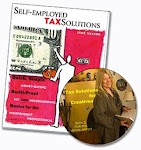The following from a client-friend in Red Bank, New Jersey
How much do you know about the federal budget?
If your answer is "not much," you're not alone. In fact, very few people have an in-depth knowledge about the federal budget process or its impact on their daily lives.
"Federal Budget 101" is designed to give you a guided tour of the budget. We outline how the federal government raises revenues and spends money, how the President and Congress enact the budget, and how much money goes into the many different federal programs. Please visit our site.
-- June
Friday, April 22, 2011
Owner's draw is not for indies.
Hi June,
Thanks for sending me the Quicken Categories For Indies List. I will go back and get your books later.
I am having a little trouble with how to categorize a Business Draw in Quicken 2011. I keep my business account and home account as separate Quicken files. So there isn't a way to "Transfer" the money. I usually write a check from one and deposit it in the other. I will try the X Change-In category on your list when I record the deposit of the Business-Draw in my personal account.
Have a great day,
Jennie
Hi Jennie,
This really calls for a lengthy explanation, but I'm going to try to make it short and clear.
Sole proprietorships don't have an owners draw situation. That's a transaction within a corporation.
A sole proprietor transfers money from one account to another. In your case it may be from a business checking account to a personal checking account.
In Quicken you may simply [hard bracket the account] in the category field.That will show the transfer in both the out and in accounts
But, if you want to give the transfer a category of its own at each side of the transfer try this:
From the going out side make it an expense category MONEY TO PSL ACCT
At the receiving side make it an income category MONEY FROM BUS CKG ACCT
Please add a comment letting me know if this helps.
Best,
June
Thanks for sending me the Quicken Categories For Indies List. I will go back and get your books later.
I am having a little trouble with how to categorize a Business Draw in Quicken 2011. I keep my business account and home account as separate Quicken files. So there isn't a way to "Transfer" the money. I usually write a check from one and deposit it in the other. I will try the X Change-In category on your list when I record the deposit of the Business-Draw in my personal account.
Have a great day,
Jennie
Hi Jennie,
This really calls for a lengthy explanation, but I'm going to try to make it short and clear.
Sole proprietorships don't have an owners draw situation. That's a transaction within a corporation.
A sole proprietor transfers money from one account to another. In your case it may be from a business checking account to a personal checking account.
In Quicken you may simply [hard bracket the account] in the category field.That will show the transfer in both the out and in accounts
But, if you want to give the transfer a category of its own at each side of the transfer try this:
From the going out side make it an expense category MONEY TO PSL ACCT
At the receiving side make it an income category MONEY FROM BUS CKG ACCT
Please add a comment letting me know if this helps.
Best,
June
Travel Expenses Made Simple
June,
I just received your checklist for expenses [Thank You] and I'm eager to order your book. My main confusion/challenge is categorizing travel expenses. Any suggestions &/or checklist for that?
Thanks in advance,
LoriAnn
Dear LoriAnn,
For tax purposes, categorizing travel expenses can be very simple. The costs fall into two categories: meals & entertainment, and everything else. That's because everything else can be deducted at 100% while you may deduct only 50% of your meals & entertainment expenses.
Here is a list of typical travel costs:
PLANE & RAIL FARES
TIPS & BAGGAGE
TAXIS & PUBLIC TRANSPORTATION
AUTO RENTALS
LODGING
TELEPHONE
LAUNDRY & CLEANING
TRAVEL MEALS
TRAVEL ENTERTAINMENT
You may read more info on travel expenses in these posts expenses -- travel
-- June
I just received your checklist for expenses [Thank You] and I'm eager to order your book. My main confusion/challenge is categorizing travel expenses. Any suggestions &/or checklist for that?
Thanks in advance,
LoriAnn
Dear LoriAnn,
For tax purposes, categorizing travel expenses can be very simple. The costs fall into two categories: meals & entertainment, and everything else. That's because everything else can be deducted at 100% while you may deduct only 50% of your meals & entertainment expenses.
Here is a list of typical travel costs:
PLANE & RAIL FARES
TIPS & BAGGAGE
TAXIS & PUBLIC TRANSPORTATION
AUTO RENTALS
LODGING
TELEPHONE
LAUNDRY & CLEANING
TRAVEL MEALS
TRAVEL ENTERTAINMENT
You may read more info on travel expenses in these posts expenses -- travel
-- June
Wednesday, April 20, 2011
Time is not a business expense.
Hello June,
I heard about your business from The National Psychologist. I am a psychologist in private practice.
Here's my question:
How do I calculate maximum deductions for Continuing Education expenses? Someone told me that for each hour spent in a CE pursuit it is allowable to deduct my hourly fee. This would be in addition to the actual cost of the CE course offering.
Also, can I deduct my hourly fee for each hour I spend in reading or pursuing informal, and therefore undocumented, Continuing Education knowledge?
Thank you for your materials and information and your focus on us indies.
Patricia, PhD
Dear Patricia,
I bet that "someone" was a psychologist, not an accountant. Or else someone who just does a lot of wishful thinking.
Your time is not a business expense. Whether you use your time to learn, to treat a patient who has no money, to volunteer at that battered women's center, or to cut the grass at the church.
Generally, you may deduct as a business expense the cost of the education, the supplies for the course, the transportation to and from the course. There are many regs regarding the deduction of education costs. And there are many ways to take advnatage of education expenses, for instance, as a tax credit rather than as a business expense. Which works best for you depends on your total tax picture.
Here are some posts you might want to read:
expenses -- donated services or products
and also some on
expenses -- education-study-research
Please send this post to someone.
Cheers,
June
I heard about your business from The National Psychologist. I am a psychologist in private practice.
Here's my question:
How do I calculate maximum deductions for Continuing Education expenses? Someone told me that for each hour spent in a CE pursuit it is allowable to deduct my hourly fee. This would be in addition to the actual cost of the CE course offering.
Also, can I deduct my hourly fee for each hour I spend in reading or pursuing informal, and therefore undocumented, Continuing Education knowledge?
Thank you for your materials and information and your focus on us indies.
Patricia, PhD
Dear Patricia,
I bet that "someone" was a psychologist, not an accountant. Or else someone who just does a lot of wishful thinking.
Your time is not a business expense. Whether you use your time to learn, to treat a patient who has no money, to volunteer at that battered women's center, or to cut the grass at the church.
Generally, you may deduct as a business expense the cost of the education, the supplies for the course, the transportation to and from the course. There are many regs regarding the deduction of education costs. And there are many ways to take advnatage of education expenses, for instance, as a tax credit rather than as a business expense. Which works best for you depends on your total tax picture.
Here are some posts you might want to read:
expenses -- donated services or products
and also some on
expenses -- education-study-research
Please send this post to someone.
Cheers,
June
Subscribe to:
Comments (Atom)




